
Desmarestia aculeata
Wiry Acid Weed, Witch’s Hair, Crisp Color Changer, Acid Kelp, Landlady’s Wig, Desmarest’s Prickly Weed
Macaulay Point, Juan de Fuca Strait, Esquimalt, British Columbia, Canada
13 December 2020, collected at 14:45 PST
High Tide 10.5 feet at 12:49 PST (measured at Oak Bay Tidal Station)
Low Tide 0.3 feet at 20:28 PST (measured at Oak Bay Tidal Station)
Weather: Mostly cloudy, no precipitation, wind variable 5 – 15 km/hour, light chop, low southwesterly swell, temperature 6˚C, relative humidity 92%.
15 December 2020, continued interactions at home
Low Tide 9.5 feet at 0908 PST (measured at Oak Bay Tidal Station)
High Tide 10.5 feet at 1356 PST (measured at Oak Bay Tidal Station)
Weather: Mostly cloudy, occasional drizzle, wind NNE 10 – 20 km/hour, temperature 7˚C, relative humidity 90%.
Phase of Moon: New Moon occurred at 08:16am PST 14 December 2020; this new moon phase was about mid-point between when we collected the live seaweed and when we started documenting the Whispering on the 15th of December.
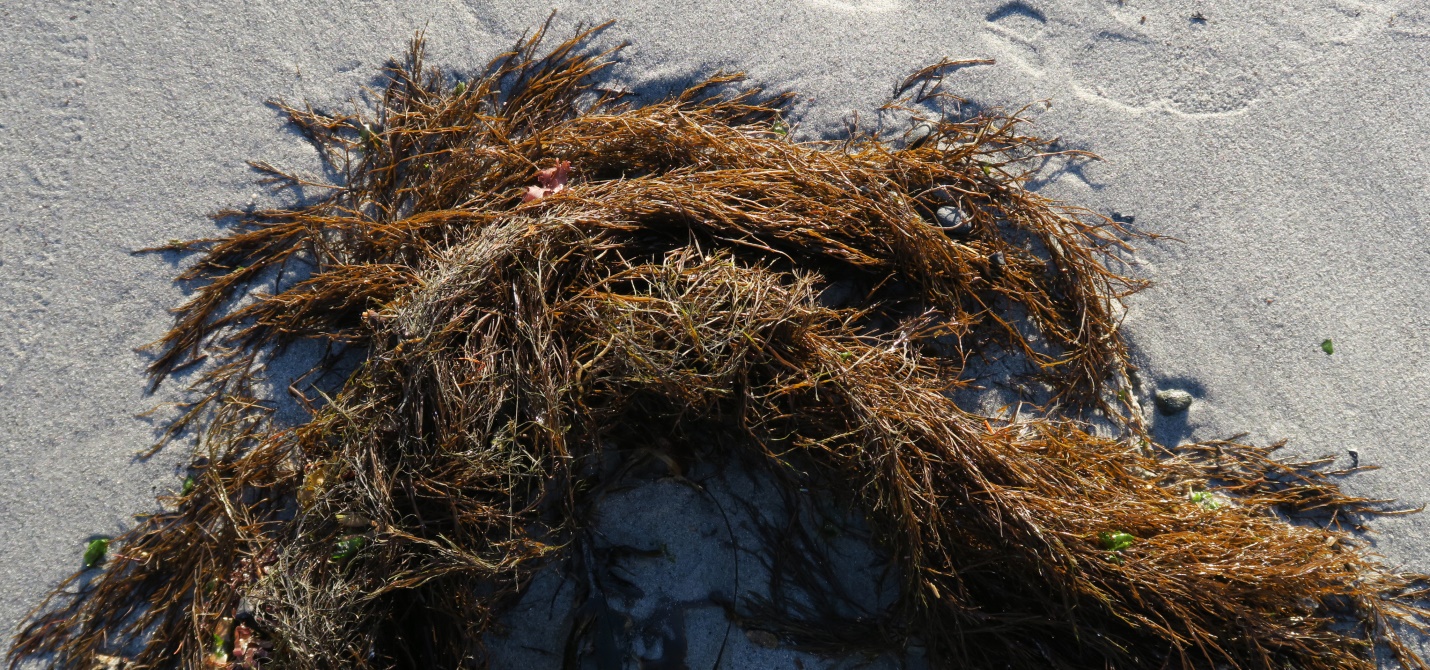
Figure 1: Desmarestia aculeata, Wiry Acid Weed – a large specimen of this alga washed ashore by a severe winter storm. Pictured here is about a one meter length of this brown alga. Gonzales Bay, Juan de Fuca Strait, B.C., Canada. December 1, 2020. Photo ID 27392 ©Seaweedwhisperings.com
Pre-Whispering documentation events & interactions:
Person 1:
Mid-way through the Whispering interaction I gained understanding of what had gone on for me in the hours following our initial collection of this seaweed.
There was an unpleasant and distinctly draining effect on me during a family outing the evening after collecting Desmarestia aculeata where we found it washed ashore. I was uncharacteristically unsociable and of low energy – really not contributing much to the outing whatsoever. I wanted to go where I wanted to go and when I wanted to go, felt somewhat irritable and uninterested in really participating or engaging. People invited me to come join them in looking at things, to go explore new areas with them, and I was greatly irritated by their suggestions / invitations.
Person 2:
After having collected the living seaweeds yesterday at Macaulay Point, I spent a short time photographing them. The next day, with better light, I did more photography and handled the individual seaweeds a fair amount (also when replenishing ocean water for them). We had plans to do our ‘formal’ interactions tomorrow. Having not yet officially begun, I recognized sometime after doing the photography this day that the interaction had, in fact, already begun. It was showing up during a routine workday in my office in the following way:
I have been feeling like I have a million threads to follow. So many of them.
And the feeling is that there are too many of them! Almost a ridiculous amount of them.
I am finding that I can’t just simply answer a message because the person I am writing too has asked questions on two additional separate topics that have to each be checked by me before replying. In this way, what seems like one task actually expands to three, four or more!
I have multiple major categories of work and each of them have “in-boxes” filling up with things that need my attention. While each of these things is distinct unto itself, the “things” also have relevance in other categories and today it is proving quite impossible for me to keep all the related aspects clear in my mind. I can follow one point, and try to conclude it. But it almost hilariously seems that if I do one thing – actually complete one thread, it also turns out that while I’m doing that 2 or 5 or 10 more things have newly shown up now also needing attention. It’s laughable to think of trying to “keep up”.
I find that I can keep little overview; no cohesive whole is possible to be grasped.
The only thing I can do is follow one thread at a time!
This is not causing me great upset, but it is abnormal for me. It’s a feeling as if I can’t control it all, or even, hardly more than one point.
Initially this felt laughable, ridiculous. However underneath that was the feeling that some things are going to get lost because there’s just too many to keep track of. The concept of things getting lost was accompanied with a deeper feeling of regret, and a wish that the loss would not be inevitable and that I could prevent it.
In situ observations:
Inclement winter weather precluded comfortable in-situ interaction; therefore we worked at home with the whole live seaweed in basins of ocean water.
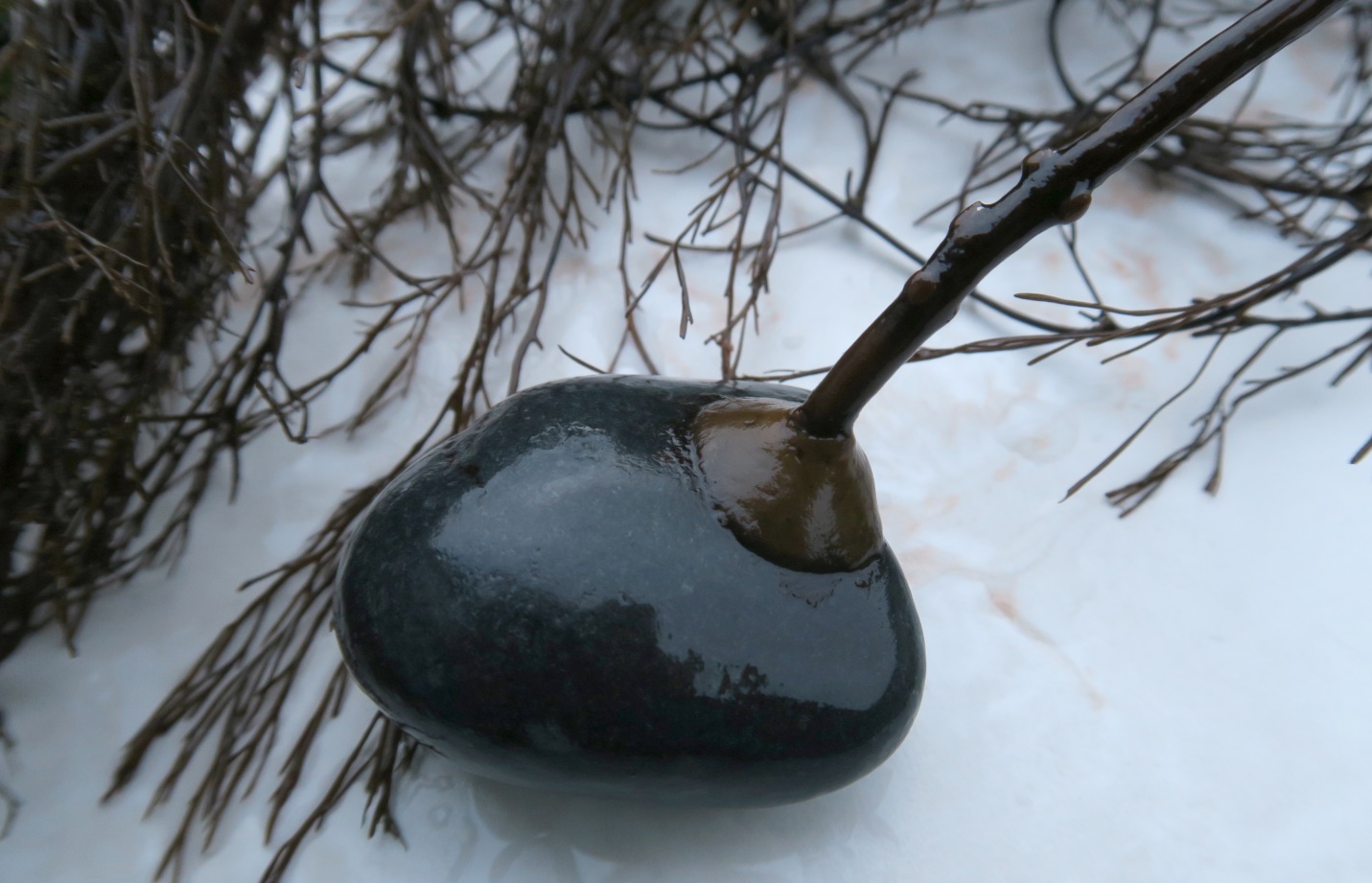
Figure 2: Desmarestia aculeata – close view of ‘suction-cup-like’ holdfast, cobble anchor and base of primary axis; live seaweed collected at Macaulay Point, Juan de Fuca Strait, Esquimalt, B.C., Canada. December 13, 2020. Photo ID 27393 ©Seaweedwhisperings.com
Person 1:
Seaweed looks strong, extending.
Unattractive superficially. Intriguing up close, but unapproachable.
When I examined it up close I realized that it was actually simple and uninteresting, just like my first impression.
Many paths (branches); many ideas and interests? But there are also many short branches suggestive of abandoned paths.
Once side branch effort is terminated, there is next more growth up the main axis (path).
The holdfast is strong and resembles a suction cup.
Clinging to the path, but wanting to grow beyond.
Dark browny-purple coloration.
Branches are rough to handle.
The seaweed swirls stiffly in the water.
Self-centred – wants to go where and when it chooses.
Not considerate of others, perhaps cruel.
Dishevelled, but doesn’t care.
Irritating and irritable.
Frayed appearance.
Loses interest.
Indeed, wiry.
Cannot be pulled apart along its main axes (stems) – very strong.
Difficult to snap.
Extremely difficult to bite and chew – no taste.
Couldn’t detect a noticeable smell beyond “ocean”.
There’s a theme of negativity.
Dissatisfaction?
Holdfast is smooth and pleasant to touch.
Loner – unsociable.
I have the image of a competitive long distance runner in his own world, fixated with his sole passion; the runner is physically strong and wiry.
Tingling in tongue, this increased with time, still present even 30 minutes after chewing the seaweed.
The notable strength of this seaweed’s energy is the ability to focus on task.
Problems of this seaweed’s energy are:
Sociopath, or at least a highly antisocial personality.
Uncooperative.
Too single-minded to expand their way of being.
Difficulty in forming or maintaining relationships due to unpleasant personality and single-mindedness.
In summing up my experience I recalled my impression when seeing this seaweed underwater (a few months ago); the impression was of a ‘sinister tangle’ – and I thought at the time “I don’t want to mess with this one”. I had the strong knowledge that “I don’t want to interact with this one” physically; I did not want to wade into the water near it, and, really, I didn’t want to engage in any way with it. This impression is one I’ve held to this day; I had not been looking forward to interacting with this seaweed.
Person 2:
On shore with tide out, you look like a collection of dirty hair, or perhaps the pelt of some unfortunate, ugly, furred creature.
A collection of many, many hairs or coarse threads – all roughly aligned.
Out of water the hairs tend to clump together.
Immersed in water your growth pattern shows up.
A single stipe (stem) arises from a conical (almost perfectly circular) holdfast. This stipe is cylindrical and tapers ever so slightly in dimension the further away from the holdfast it grows. It looks like a cluttered mess of countless thin branches, this seaweed, but if I observe closely I can see that your branches grow in alternate positions up the main stem. Each of these side branches also sends out side branches and they too have tiny branches – each with alternating or irregular growth pattern. Following with my eye, I see that even these thin branches will branch yet again.
In the water and given adequate space, all these thread-like or hair-like or wire-like branches fan out, and the clumping must therefore be something that occurs when this subtidal seaweed is stressed and removed from its watery environment.
Always branching.
Simple thread-like stems.
Always on alternating sides.
Dimensions smaller and smaller with each division.
When clumped together, such as in my basin now, you even remind me of a horse’s tail – thick, coarse hairs, tapering overall near the end.
Your color when I hold you up so you are back-lit is an olive brownish green.
Not an attractive color to my eye.
More like an army camouflage green.
Something designed to not stand out, but to blend in and to be not seen.
Your color is bland, some would say drab or even ugly.
Your texture to my touch IS wiry. A contrast from the look of you, which could suggest a finer and softer quality. You do not have soft hairs/threads, but tough ones, coarse feeling, like horse’s hair or fine wires.
Your larger main stems are also tough and very strong, but unlike the smaller branches these main stems feel smooth.
Running my fingers through your branches and branchlets, it feels coarse, almost gritty.
Are you tough – like a character from “True Grit”?
Maybe you are unadmired – ugly, drab, coarse, no sheen and minimal pattern (no fancy leaf ruffles or flotation bladders) – so, is this how you develop your grit? You toughen up because from the outside you have little showy physical beauty?
Your suction-cup-shaped holdfast looks again very simple in design, but also very effective at holding you to your cobble.
In fact, the holdfast and strong stem can be, at times, too effective – as this individual specimen we collected had been propelled through the intertidal zone by the last big surf and ocean swells and it held true and fast – so much so that the whole plant was washed ashore and stranded, complete with its cobble anchor.
Do you hold on too tightly?
What do you hold on to?
What is it that you do not want to let go of?
I now pulled off a smaller stem to investigate the taste and smell of this seaweed.
No smell.
Chewing you is NOT easy or pleasant.
The inside of my mouth quickly went dry, my saliva has lost its slipperiness, I puckered my cheeks.
I soon spat out the bits of Wiry Acid Weed. My chewing has broken the tiny thread-like stems into small lengths, yet they are not otherwise crushed.
The inside of my lips remain irritated, feel somewhat swollen, missing their normal lubrication.
Taste was not too strong – but of something chemical-like that I’ve (thankfully) not tasted before. There was a faint iodine taste too.
If I wasn’t trying to investigate the taste I would have immediately spat out this seaweed after one or two chews.
The main stem is very strong.
I pulled hard and it does not yield.
I can bend it in a tight “hairpin” shape and it doesn’t break.
My fingernail cannot score or pierce it.
Use of a hand lens reveals:
Tips of your tiny threadlike branches taper to a point.
The edge of your holdfast is a bit chewed and/or abraded.
Your texture does indeed look smooth on main stems.
Stepping back to review your overall look, it is one of so very many lines, threads, wires, hairs!
They’re far too numerous to count or keep track of.
Do you even try to keep track?
Is it just an instinct you have, an URGE to keep growing on, making more threads, branching some more, yet you find yourself simply still doing the same thing, repeating the same thread-like growth pattern.
Maybe you like wiry threads – maybe you are the perfection of “thread expression” but it seems that you aren’t valued for that ability. And possibly as a result, internally you don’t even quite value your “perfect thread” self either, Desmarestia?
You can grow very big, all comprised of these wiry, thread-like hairs.
That’s all you can do, and to you it doesn’t feel like that’s really quite enough. You sense you’re lacking something and that saddens you, perplexes you a bit, and has you feeling dissatisfied and malcontent.
But those feelings don’t motivate you too much, in a sense they justify your point of view – “I am not admired”, “No one wants a ‘perfect-thread expression’ or so it seems”; “When did I lose favor in the world?” “Why did I lose favor?”
Is each thread trying to find that sense of value?
Is each thread just one more unsatisfactory attempt that adds to an increasing sense of bitterness?
Or are the threads a chronological record, one level after another, of all that you have done?
Each thread a day, a week, an event, a memory?
But somehow, even though these threads are all linked together, they don’t really tell an overall story.
Each thread is a small junket or jaunt, and together they don’t appear to amount to anything cohesive, BUT they are a massive collection of sorts.
On their own, each junket, each branch is too insignificant to be of note.
All together the collection has no cohesion.
Is this what you strive for then?
Cohesion?
Understanding?
A history of yourself?
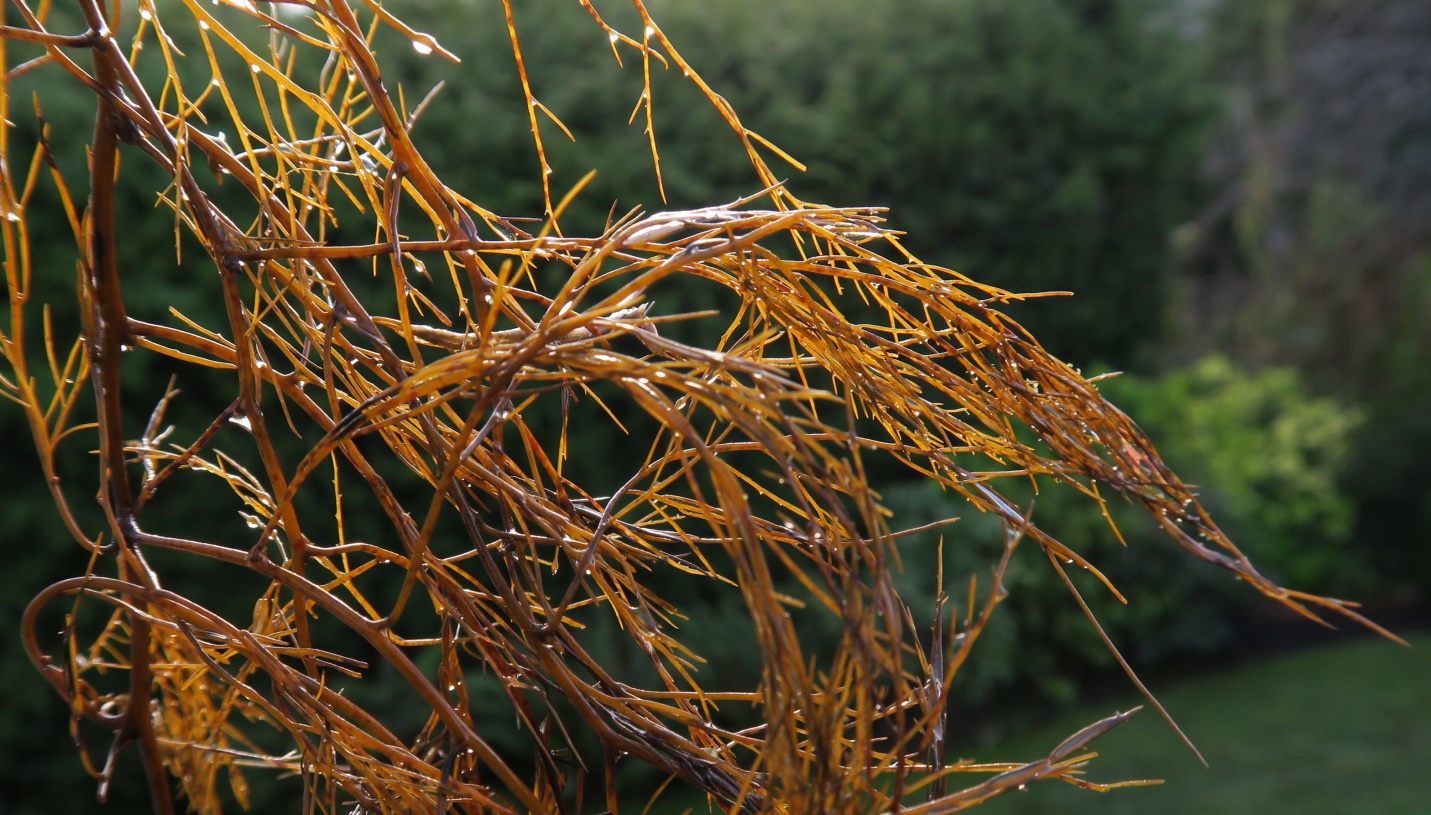
Figure 3: Desmarestia aculeata, Wiry Acid Weed – view of part of the stem and branches; back-lighting reveals color. A careful look shows the alternating or irregular growth pattern of the branches from the main axis which is definitive to this species of Acid Weed. The pointed tips of the fine, wiry, thread-like branches are also evident. December 14, 2020. Photo ID 27394 ©Seaweedwhisperings.com
So Many Names:
As if mirroring the “so many” branches growth pattern, Desmarestia aculeata also has “so many” common names. Amongst the ones we found in our references are:
Wiry Acid Weed; Witch’s Hair; Crisp Color Changer; Acid Kelp; Landlady’s Wig; Desmarest’s Prickly Weed. We explored the names a bit.
Person 1:
“Wiry Acid Weed”: Wiry – appropriate description of look and feel of this seaweed.
Acid – unpleasant personality.
Weed – outcast.
“Witch’s Hair” – dishevelled, dark (almost black) appearance.
Witch – evil.
“Crisp Color Changer” – deception.
“Acid Kelp” – stinging persona.
“Landlady’s Wig” – caricature of elderly, unkempt landlady.
“Desmarestia aculeata” – Desmarestia – nice sounding surname. Aculeata – sharp tongued.
Person 2:
“Desmarestia” – reminds me of an old-fashioned female name, Esmeralda. A name which for some reason seems not very pretty or flattering at all. I also hear “arrest” in this; I wonder about this seaweed, what is arrested or stopped within it, by it, for it?
“Aculeata” – I don’t know the Latin meaning, but I hear something about “collating”, and a feeling of “having direction” in this name.
“Wiry Acid Weed”/”Acid Kelp” – it is lean and wiry, this seaweed, for certain. Acid maybe comes from a constituent…, something that irritated my mouth when chewing and that gave me a puckered expression. Acid is also descriptive of how this seaweed’s energy feels – sharp, coarse, rough, harsh, sometimes bitter and acerbic – like it’s lost something and knows it cannot get it back.
“Witch’s Hair” – hair-like for sure, hair of a witch..., I guess I would agree if you think of the Halloween caricature – unkempt, dark, dirty not attractive in any way.
“Landlady’s Wig” – again a hair-piece, yes, and maybe the landlady can’t afford a good one?
Hair – Person 1 put a clump of this seaweed on his head when we were out exploring the seashore earlier this summer. It looked very much like long hair and Person 1 felt like he was being a bit of a jokester by doing this. Wigs can be used for disguise or to change ones appearance.
“Crisp Color Changer” – unsure of the relevance of this name except some parts of you are much darker, almost purple brown, and others are lighter greenish brown. Changing colors due to what? Is it a camouflage…, a costume…, a disguise…, a reaction to the presence of something you do not tolerate?
This seaweed has so many common names.
Is it therefore difficult to name, to pin down with only one description? Again, deception or disguise / camouflage? Which trait shall be used for naming?
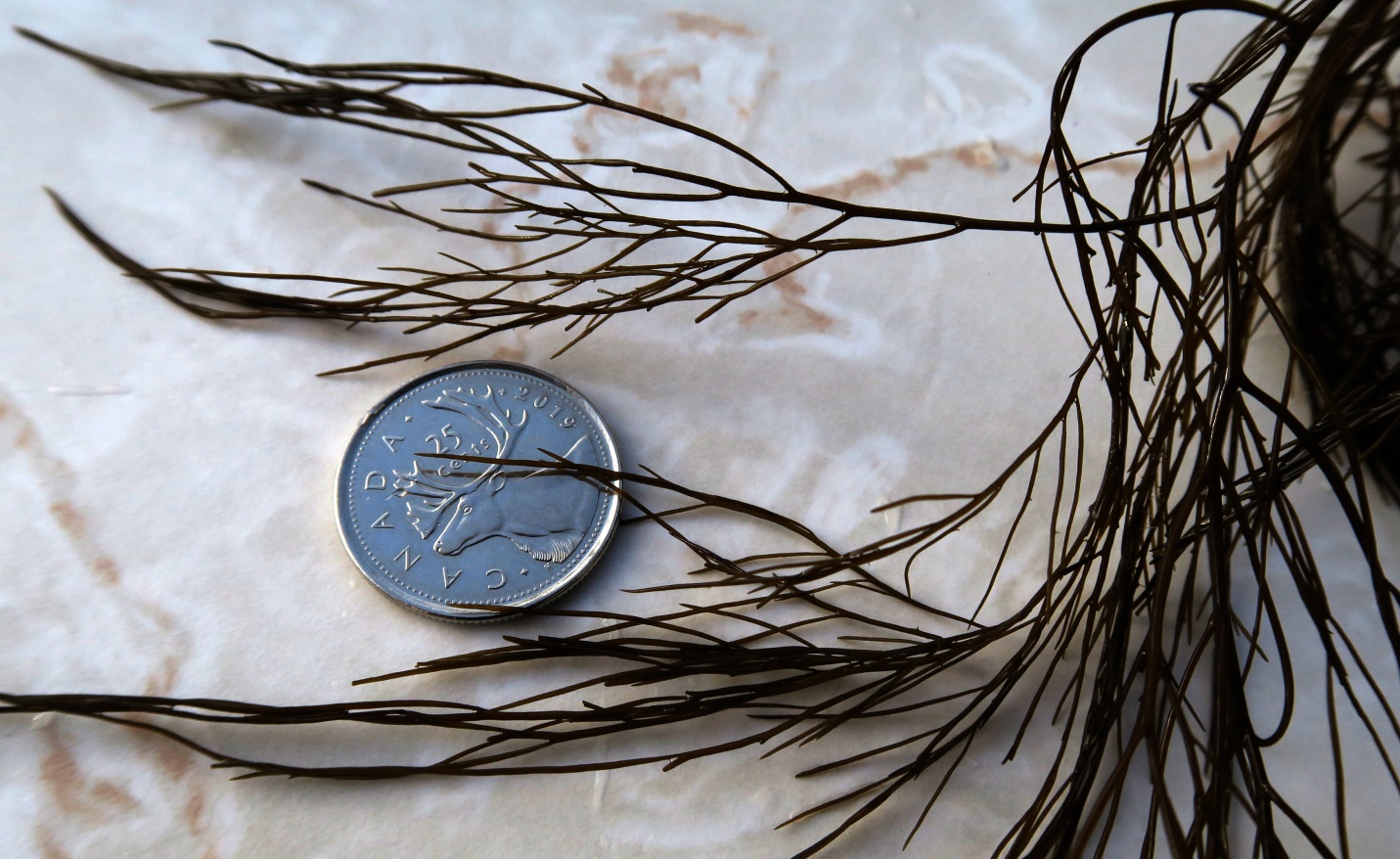
Figure 4: Desmarestia aculeata, Wiry Acid Weed – closer view with Canadian quarter (diameter 23.5 mm) for size reference – the threads are very fine but even at narrow diameter, they retain their coarse, wiry strength. December 14, 2020. Photo ID 27395 ©Seaweedwhisperings.com
Discussion:
“Focusing on the energy of this seaweed exhausted me”, Person 1 concluded. He just about fell asleep while interacting and observing and note making, despite being well rested. “Being in this seaweed’s energy is draining”.
Person 2 had a similar experience feeling quite weary after interacting with Desmarestia aculeata; a bit sleepy, but actually more weary. The questions arose:
Shall I lie down to rest awhile?
Or possibly do something to “break the spell” – step outside, maybe? “Spell”, yes that is a fitting word for a seaweed named Witch’s Hair; one thing a witch can do is cast a spell.
There may be something going on with energy use, too, for this seaweed. Is the fuel it uses not fully combusted? Is it inaccurately inventoried or are there fuel storage issues? A usual sized luncheon salad today seemed far too big; is the appetite somehow lacking in this seaweed? Is this how you get to be so thin and wiry, Desmarestia aculeata?
Irritation, irritation, IRRITATION! While transcribing our notes to digital format, there was again the feeling of irritation. Person 1 felt irritated that he felt he had to more fully explain his wording and thoughts. Person 2 felt irritated that Person 1 was unable to understand what was unclear. In short, there was a marked lack of usual cooperation or teamwork between us. There was instead a miffed, disgruntled, irritated feeling. As our transcribing of notes proceeded the “drained” and “exhausted” feeling returned notably, also.
“Not” – a theme of negativity; there was to this seaweed the feeling of being steeped in dissatisfaction.
One of the first things noticed in our notes were the frequent use of words like “not” or the prefix “un” or the qualifier “but”; it’s “un”-attractive, it’s “un”-approachable, it’s “not” considerate “but” it also doesn’t care.
Caricature. An exaggeration to hide what is truly beneath.
Costume, camouflage, deception, and disguise – these words all link in here.
Is this a witch, an unkempt landlady, a fit and lean long distance runner? Or is this only the caricature; the covering that catches and deflects attention from what is truly within.
So caricature can block from view what is beneath. You may not be trying to hide something from others, Desmarestia, but in focusing single-mindedly, and even with succeeding at focusing on something so narrow, it seems that this could hardly be much of an expression of yourself. At most it could be only one small part, so are you sometimes only knowing and working with the caricature.
And at times the aspects of: jokester, laughable, ridiculous, hilarious, these come into use. Does this cover up what is lost? Soften the realities of damage, defeat or grief.
An exaggerated, cutting and sharp sense of humor, indeed even self-deprecating humor, can confuse others.
Changing colors?
To deflect attention or change the subject – avoidance of going more deeply (in discussion with another, or with one’s own self). Or, does the color change mark a transition; denote a passage, or a transformation?
There is a “fit” to this energy, the self-focus and the physical appearance of being strong and wiry. That is not a normal body characteristic; it’s an exaggerated body characteristic. The mental single focus is also an extreme.
Person 1 saw the ‘focus’ mostly – tough, wiry, going along the main stem.
Person 2 saw the ‘distractions from’ the focus - the side things (branches) that go out. That’s what irritates you, Desmarestia, the side things and your experience that they don’t lead anywhere.
Holding on or old fashioned (Esmeralda); in this seaweed it is like holding on to previous successful approaches, i.e. you can only grow wiry threads. The holding on means it’s not possible to move on, learn new ways or update one’s ideas. It’s also retaining something in current times that is not really appreciated any longer, so can be easily judged as ugly or unattractive.
Concerned about losing something – a fear of inability to restore it, get it back.
Once changed (color changer) you cannot go back.
Appetite suppressed, can’t afford a good wig, lean & wiry. These all tie in to the quality in this seaweed’s energy about some areas where abundance is lacking or nurturance from what is available to them is not performing well, not quite working as intended.
Attrition, deterioration, wearing away, abrasion, corrosion – all good words for this energy and for “Acid Weed”.
Also felt is the desire to act against this natural attrition process. To somehow prevent the loss...
Doesn’t tolerate much. Can be a bit too narrow minded. Can have too small a focus, therefore not much else meshes with that.
When in presence of something not well-tolerated then changes colors, arrests action, retreats back to main path (axis)?
Difficult to pin down or describe with only one name.
When you see this seaweed, the first impression is, oh, what a mess of material! It’s so cluttered you can’t figure it out; there’s no clear identifying feature.
There’s also the issue that you could be repelled by the ugliness, the negative energy emanating, almost like finding a half decayed corpse lying on the seashore and you don’t want to become involved enough to figure it out.
Can ‘naturally’ repel others.
Others quickly reject you.
It seems that there is also some self-rejection, and certainly self-deprecation.
Initial impressions last, though. A person in this energy is not trying TO stand out or to NOT stand out. They’re not deliberately trying to be one or the other. The limelight is not sought, and yet there is a desire that all is not lost to anonymity and unimportance.
Branch tips end in a point – you could think this suggests direction, but in fact, the feeling is “it goes nowhere”. This then can instead be ‘prickly’ rather than pointed.
Branches go nowhere that is satisfying, so the branch is soon aborted. Yet each branch’s effort is a vestige of a past effort and some of the ends are broken or frayed; these are not discarded, but also don’t retain much current-day importance.
So there are two elements here – one is to just leave things wherever and however they end up, and the other is to retain or preserve or hold on to each “branch” in its best form, perhaps like the efforts of a good archivist or historian.
The seaweed seems to do both; it can’t go back and repair old branches, it doesn’t dwell on those details, but equally, the old branches aren’t actually discarded. They are evidence of past history.
Recording and archiving…, another point on this theme: with this Whispering, more than any other we’ve done, if we were experiencing one aspect of the energy of this seaweed, once we noted it down in our record, that aspect lifted and cleared from our awareness. Once documented any impact of the energy was no longer experienced, and indeed some of it was experienced quite viscerally, indeed.
Hold on too hard – to your own detriment, even death!!
Ah, and perhaps sometimes, Desmarestia, you are holding on to the wrong thing.
If you’re on bedrock, you’re not going to be washed ashore, but if you “hold on” to a small cobble, well…., this is how we collected our living, but soon to be dying, specimens. If you hold on, first assess with care.
Possibly in this energy there can be too little discernment about what is important to hold on to, and what is best let go of.
Trying to hold on…, this is exhausting.
The solution – write it down, document the history, write your autobiography, organize your collection of memories or mementos!
Then, you can relax and not carry the burden of impeding loss.
Then you can have some energy freed up.
But discernment is helpful; If everything is archived / preserved / held onto, this means there is no possibility for things to naturally fade away. There is no possibility to NOT endure, to NOT have to last forever, to NOT be permitted to join in the natural cycle of life and death.
With this write up, there was a desire to leave the discussion in short pieces.
To not edit for full sentences, nor always make proper paragraphs.
It felt ‘right’ to document these concepts in small pieces.
It also felt right to not attempt to tie it all together; that such an effort would be a misrepresentation.
Returning specimens to the sea:
When we completed our interactions and observations we took the seaweed specimens to a gravel beach at Ross Bay and returned them to their environment.
Person 1 noted that as he was attempting to return the specimens to the sea that a piece of Desmarestia aculeata clung to the handle of his bucket and would almost comically not come free. This reminded him of the themes of “holding on” and “not letting go” and brought back some quality of ridiculousness that had been experienced during our earlier interactions.
After finally releasing all the Desmarestia aculeata seaweed to the sea, he felt a lightness of spirit. This contrasted with the rather heavy and somewhat negative energy that he had felt since we first collected it. In the “heavy negative energy” state he felt he was slow to accomplish anything, as if he was not moving fast, not getting much done…, this was not experienced like a struggle, but like an alternate reality wherein everything occurred in a slow and ponderous way. “Letting go” of that was lightening to the spirit, indeed.
Person 2 found that the cumbersome nature of this seaweed’s energy did NOT end until she had completed all documentation work and filed the record properly away. She felt relief to be finished, to be free of the unpleasantness and the irritation and the some of the other distinctly negative qualities experienced, but also realized she would be unlikely to forget the sense of grateful recognition and simple release from Desmarestia once acknowledgement and or suitable documentation had been made. So Wiry Acid Weed, you are tricky to work with, but you are not without your own innate value and merits.
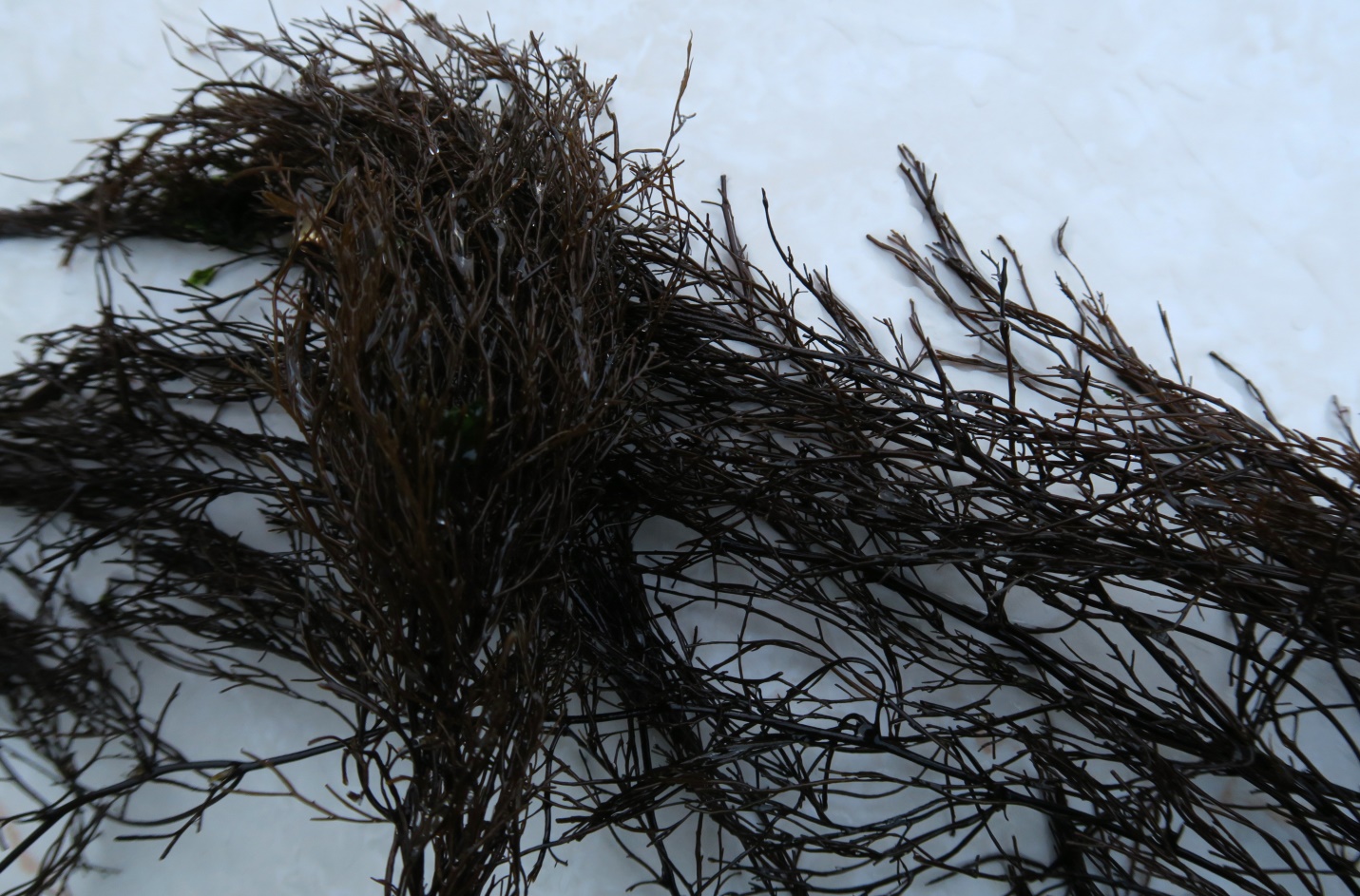
Figure 5: Desmarestia aculeata – a clutter or jumble of branches. This specimen hints at the “witch’s hair” or “landlady’s wig” look of the slender thalli and branches. December 13, 2020. Photo ID 27396 ©Seaweedwhisperings.com
Biology & Natural History Information:
Description:
The large conspicuous generation, spring to summer annuals, are the spore bearing phases that alternate with a microscopic, filamentous, gamete-producing phase. The dark to light brown, coarsely cylindrical, wiry thallus grows only on rocks. In some regions it is reported to be bright green when young and brown when older. A small discoid holdfast gives rise to the main axis which is up to 5 mm in diameter and up to 120 – 200 cm in length. This main axis bears profuse branches that have an alternate or irregular branching pattern; some side branches are pinnate (feather-like) while others are simple. This genus is noted for a distinctive pattern of growth which features intercalary meristems; new cell growth occurs in the ‘middle of the stems’ as is seen in land plants such as grasses. In Wiry Acid Weed the meristems of the side branches are located near where they branch off the main axis.
Habitat:
This perennial brown alga is found on rock, including cobble, in the very low intertidal and upper subtidal zones (to a depth of about 15 m) of protected to semi-exposed habitats . A good minus tide is necessary to see Desmarestia aculeata where it grows, and masses of this species are commonly found washed up on beaches after storms.
Distribution:
Aleutian Islands, Alaska to Oregon; Arctic Ocean; western North Pacific; North Atlantic; North Sea.
Remarks:
This Genus is names after A.G. Desmarest, a French naturalist. This is the type species (holotype) of the genus Desmarestia.
Other species of Desmarestia form vast kelp forests on the shallow sea floor around Antarctica. Members of the Desmarestiales probably originated in the southern hemisphere where the greatest diversity of species still occurs – some rivaling northern hemisphere kelps in their size and morphological complexity.
The various Desmarestia species contain chemicals that upon contact with sea water form sulphuric acid; a mechanism most probably designed as a defence against invertebrate grazers, especially sea urchins. Rightly named “Acid Weed” the internal pH of Desmarestia has been estimated as low as 0.6pH; for reference, the gastric acid of the average human stomach which liquefies food sits roughly at 1.5 to 3.5. Handling Desmarestia with bare hands will not cause harm, however when these algae are exposed to physical damage or high temperatures, Sulphuric acid released from broken vacuoles will destroy the Acid Weed itself and other nearby seaweeds as well.
Former name(s): Fucus aculeatus Linnaeus 1763
Classification:
Phylum: Ochrophyta
Class: Phaeophyceae
Order: Desmarestiales
Family: Desmarestiaceae
Genus: Desmarestia
Species: Desmarestia aculeata (Linnaeus) J.V.Lamouroux 1813
![]()